
No data
Do you want to know which is the better broker between Plus500 and Saxo ?
In the table below, you can compare the features of Plus500 , Saxo side by side to determine the best fit for your needs.
You can determine the reliability and credibility of a broker by checking four factors:
1.Forex broker introduction。
2.Are the transaction costs and expenses of plus500, saxo lower?
3.Which broker is safer?
4.Which broker provides better trading platform?
Based on these four factors, we can compare which is reliable. We have broken down the reasons as follows:
| Plus500 Review Summary of 10 Points | |
| Founded | 2008 |
| Headquarters | Israel |
| Regulation | FCA, CySEC, ASIC, FMA, MAS |
| Market Instruments | forex, cryptocurrencies, stocks, indices, commodities, and options |
| Demo Account | Available |
| Leverage | 1:30 (forex), 1:20 (indices), 1:10 (commodities), 1:2 (cryptocurrencies), 1:5 (stocks) |
| EUR/USD Spread | 0.5 pips |
| Trading Platforms | own proprietary trading platform (desktop, web, and mobile) |
| Minimum deposit | $/€/£100 |
| Customer Support | 24/7 email, WhatsApp and live chat |
Plus500 is an online trading platform that offers Contracts for Difference (CFDs) on a range of financial instruments including stocks, forex, commodities, cryptocurrencies, options, and indices. The platform was founded in 2008 and is headquartered in Israel, with additional offices in the UK, Cyprus, Australia, and Singapore. Plus500 is authorized and regulated by several financial authorities, including the Financial Conduct Authority (FCA) in the UK, the Cyprus Securities and Exchange Commission (CySEC) in Cyprus, and the Australian Securities and Investments Commission (ASIC) in Australia. The platform is available in more than 50 countries and supports over 30 languages.
Plus500 is a CFD (Contracts for Difference) broker, which means that it offers trading on derivatives based on various financial assets without actually owning the underlying assets. Traders can speculate on the price movements of assets such as stocks, forex, commodities, cryptocurrencies, and indices without having to buy or sell the assets themselves. As a CFD broker, Plus500 allows traders to take both long and short positions, and offers leverage which can increase potential profits (and losses).

Plus500 is a good option for traders looking for a user-friendly platform to trade a wide range of markets and instruments, with competitive spreads and no commissions.
However, traders who require advanced charting tools, educational resources, and alternative trading platforms may need to consider other brokers.
| Pros | Cons |
| • Simple and easy-to-use trading platform | • Limited product offering |
| • Commission-free trading | • Limited research and educational tools |
| • Tight spreads | • No support for MetaTrader platform |
| • Negative balance protection | • Limited customer support options |
| • Regulated by reputable financial authorities | • No phone support |
| • Free demo account | • Withdrawal fees for some payment methods |
| • Limited trading tools and features |
Note that the information presented in the table is based on general observations and may vary depending on individual circumstances and preferences.
There are many alternative brokers to Plus500, and the best one for you will depend on your individual trading needs and preferences. Here are some popular alternatives to Plus500:
eToro: eToro is a social trading platform that allows you to copy the trades of other traders. It offers a wide range of trading instruments and has a user-friendly platform.
IG: IG is a well-established broker that offers a wide range of trading instruments, including forex, stocks, and commodities. It also offers a range of educational resources and has a user-friendly platform.
XM: XM is a popular broker that offers competitive spreads and a range of trading instruments, including forex, stocks, and commodities. It also offers a range of educational resources and has a user-friendly platform.
Pepperstone: Pepperstone is a popular broker that offers competitive spreads and a range of trading instruments, including forex, stocks, and commodities. It also offers a range of educational resources and has a user-friendly platform.
IC Markets: IC Markets is a popular broker that offers competitive spreads and a range of trading instruments, including forex, stocks, and commodities. It also offers a range of educational resources and has a user-friendly platform.
It's important to do your own research and compare the features and fees of different brokers before making a decision.
Plus500 is considered legitimate as it is authorized and regulated by several top-tier financial authorities, including the UK's Financial Conduct Authority (FCA) and the Australian Securities and Investments Commission (ASIC). Plus500 is also publicly traded on the London Stock Exchange, which provides additional transparency and accountability. The broker has been in operation since 2008 and has a large and established customer base. However, it is worth noting that no broker is entirely risk-free, and traders should always do their own due diligence before depositing funds with any broker.
Plus500 takes several measures to ensure the safety and protection of its clients, and the fact that it is a regulated broker provides additional reassurance to clients. Here is a table outlining how Plus500 protects its clients:
| Protection Measure | Detail |
| Segregated Funds | Client funds are kept separate from company funds |
| Negative Balance Protection | Clients can't lose more than their account balance |
| Risk Management Tools | Stop loss, limit order and other tools to help manage risk |
| Account Verification | Rigorous account verification process to prevent fraud and unauthorized access |
| SSL Encryption | Secure Socket Layer (SSL) encryption used for all communication and data transfer |
| Regulatory Oversight | Regulated by multiple reputable financial authorities |
| Investor Compensation Fund | Eligible clients may receive compensation in the event of insolvency or bankruptcy |
Note: This table provides a brief overview of Plus500's client protection measures and is not exhaustive. Clients should always refer to Plus500's official website and legal documents for complete and up-to-date information.
Overall, Plus500 appears to be a reliable broker with a strong emphasis on client protection. The company is regulated by multiple reputable financial authorities, has a robust risk management system in place, and offers negative balance protection to clients. Plus500 also uses encryption technology to protect clients' personal and financial information.
However, it is important to note that no broker is completely risk-free, and clients should always carefully consider their investment goals and risk tolerance before trading with any broker.
Plus500 offers a wide range of trading instruments including:
Forex pairs - major, minor, and exotic currency pairs
Stocks - CFDs on stocks from various international markets
Indices - CFDs on major stock indices like S&P 500, Nasdaq, FTSE 100, and more
Commodities - CFDs on precious metals, energies, and agricultural products
Cryptocurrencies - CFDs on popular digital currencies like Bitcoin, Ethereum, Litecoin, and more
Plus500 offers two types of accounts: a live trading account and a demo account.
The live trading account requires a minimum deposit of $100 and provides access to real-time market prices and trading in over 2,000 instruments. Traders can use leverage of up to 1:30 for retail clients and up to 1:300 for professional clients. The live account offers various features such as stop loss, take profit, and guaranteed stop loss orders. There are no commissions charged on trades. Instead, the company earns money through the bid-ask spread.
The demo account is free and allows traders to practice trading using virtual funds with access to the same trading instruments as the live account. It is a great way for traders to learn how the platform works, practice trading strategies, and get familiar with trading instruments before investing real money. The demo account is available for unlimited time and can be used to test new trading strategies without the risk of losing real money.
Plus500 offers leverage for different financial instruments. The maximum leverage offered depends on the instrument and the jurisdiction where the trader is located. In general, the leverage for forex trading can be up to 1:30 for retail clients in the European Union, and up to 1:300 for professional clients.
For other instruments, such as stocks, commodities, and cryptocurrencies, the leverage can vary between 1:5 and 1:30 for retail clients, and up to 1:300 for professional clients.
It's important to note that higher leverage can amplify both profits and losses, and traders should use it with caution and proper risk management.
Plus500 offers floating spreads on all trading instruments, meaning the spreads can fluctuate based on market conditions. The spreads can start from as low as 0.5 pips for major currency pairs like EUR/USD. Plus500 does not charge any commission on trades, and their revenue comes solely from the spreads offered.
Below is a comparison table about spreads and commissions charged by different brokers:
| Broker | EUR/USD Spread | Commission |
| Plus500 | 0.5 pips | No |
| eToro | 1.0 pips | No |
| IG | 0.75 pips | Yes |
| XM | 1.6 pips | No |
| Pepperstone | 0.16 pips | Yes |
| IC Markets | 0.1 pips | Yes |
Note that spreads and commissions are subject to change and can vary depending on the account type, trading platform, and other factors. Traders should always check the broker's website for the most up-to-date and accurate information.
The Plus500 trading platform is an in-house developed web-based platform that can be accessed directly from the Plus500 website. The platform is user-friendly and intuitive, making it easy for traders to navigate and trade various financial instruments. It is also available in several languages.
The Plus500 trading platform offers several advanced features, including price alerts, real-time charts, and technical analysis tools. The platform also includes a demo account that traders can use to practice trading without risking any real money.
Overall, the Plus500 trading platform is well-designed and functional, but it may lack some of the advanced features found in other trading platforms. See the trading platform comparison table below:
| Broker | Trading Platforms |
| Plus500 | Plus500 WebTrader, Plus500 Windows Trader, Plus500 mobile app |
| eToro | eToro WebTrader, eToro mobile app |
| IG | IG Trading Platform, IG mobile app |
| XM | MetaTrader 4, MetaTrader 5, XM WebTrader, XM mobile app |
| Pepperstone | MetaTrader 4, MetaTrader 5, cTrader, Pepperstone mobile app |
| IC Markets | MetaTrader 4, MetaTrader 5, cTrader, IC Markets mobile app |
Plus500 offers several deposit and withdrawal methods, including:
Credit/debit card (Visa or Mastercard)
PayPal
Bank transfer
Electronic wallets (Skrill, Neteller)
It's worth noting that the availability of certain payment methods may vary depending on your location.

Plus500 does not charge deposit or withdrawal fees, but some payment providers may charge transaction fees, which should be checked with the provider directly. Plus500 also requires users to withdraw funds using the same payment method that was used for depositing funds, up to the deposited amount. Any excess profits can be withdrawn using any other payment method supported by Plus500.
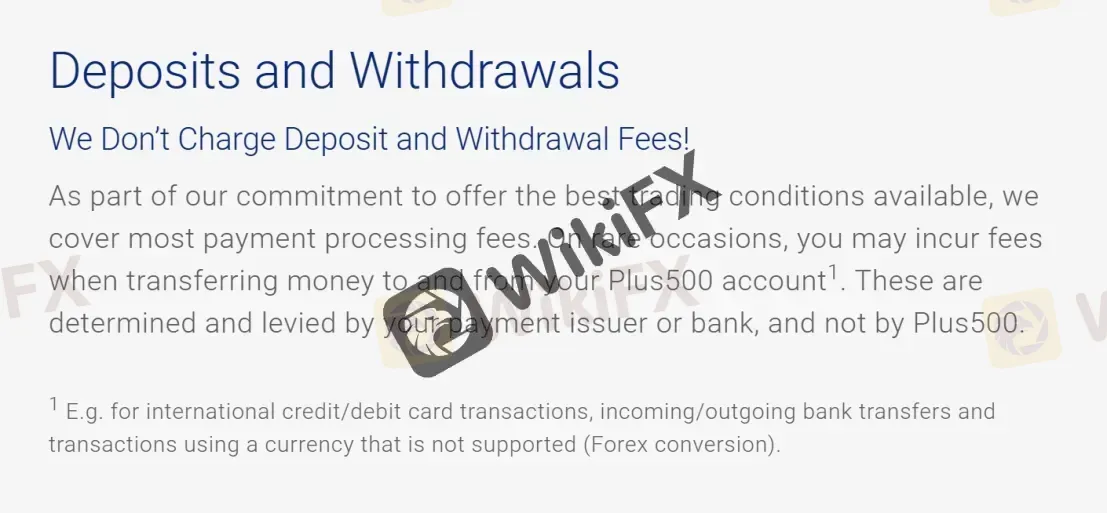
The minimum deposit requirement for Plus500 varies depending on the jurisdiction and the account type. In general, the minimum deposit ranges from $100 to $1,000. For example, in the UK, the minimum deposit is £100. In Australia, it is AUD 100, and in the EU, it is €100. It is recommended to check the specific minimum deposit requirement for your country and account type on the Plus500 website.
| Plus500 | Most other | |
| Minimum Deposit | $/€/£100 | $/€/£100 |
To withdraw funds from Plus500, you need to follow these steps:
Step 1: Log in to your Plus500 account and click on the “Funds Management” tab.
Step 2: Click on “Withdrawal” and select your preferred withdrawal method.
Step 3: Enter the amount you wish to withdraw and any additional information required for the withdrawal method you have chosen.
Step 4: Click on “Submit” to initiate the withdrawal process.
It is worth noting that Plus500 may require additional documentation or information to verify your identity before processing your withdrawal request. The processing time for withdrawals may also vary depending on your chosen withdrawal method.
Plus500 charges overnight funding fees for holding positions overnight. There are no fees for deposits and withdrawals, and inactivity fees only apply after three months of inactivity.

The overnight funding fee is a cost incurred for holding positions overnight and can be a credit or debit to your account depending on the direction of the position and the prevailing interest rates. The funding rate varies based on the instrument traded.
It is important to note that Plus500 may also charge additional fees for certain actions like guaranteed stop-loss orders or currency conversions.
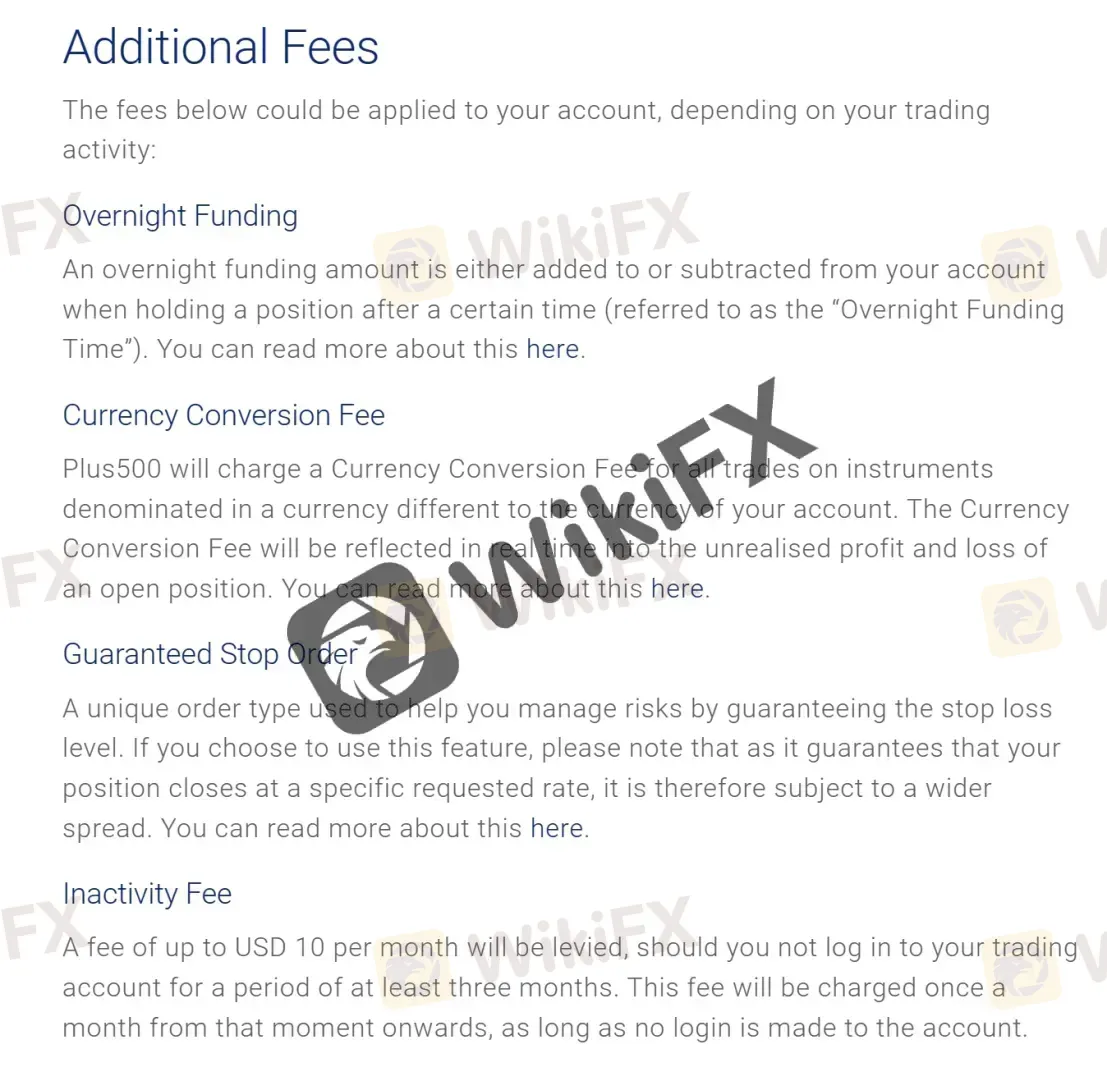
Overall, while the fees for Plus500 are relatively low, traders should be aware of the potential for higher overnight funding fees, as well as any additional fees that may apply for certain actions.
See the fee comparison table below:
| Broker | Deposit Fee | Withdrawal Fee | Inactivity Fee |
| Plus500 | Free | $5-$10 | $10/month |
| eToro | Free | $5 | $10/month |
| IG | Free | Free | $18/month |
| XM | Free | Free | $5/month |
| Pepperstone | Free | Free | $0 |
| IC Markets | Free | $3.5 | $0 |
Plus500 offers customer service through email, WhatsApp and live chat. The live chat is available 24/7, while email and WhatsApp support is available during business hours. Plus500 also provides an extensive FAQ section on their website, which covers many commonly asked questions about their services and trading platform.

You can also follow Plus500 on some social networks such as Facebook, Twitter and Instagram.
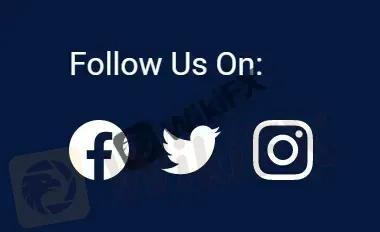
Overall, Plus500's customer service is considered to be adequate, with prompt responses and helpful support staff. However, some users have reported difficulty reaching support during busy times or experiencing long wait times for responses to their queries.
| Pros | Cons |
| • 24/7 customer support via live chat | • No phone support available |
| • Multilingual support | • Sometimes response is not prompt |
| • User-friendly help center and FAQ section |
Note: These pros and cons are subjective and may vary depending on the individual's experience with Plus500's customer service.
Plus500 provides an educational section on their website, which includes video tutorials, a demo account, and a FAQ section. The educational resources cover topics such as trading basics, technical analysis, and risk management. However, the educational content is relatively limited compared to some other brokers and may not be sufficient for beginners looking to learn about trading.
Overall, Plus500 is a reputable and reliable online broker that offers a user-friendly trading platform, competitive spreads, and a wide range of trading instruments. It has a strong regulatory framework and offers various measures to protect its clients. Plus500 also provides excellent customer service with a 24/7 support team available via live chat.
However, Plus500 does have some drawbacks, such as limited educational resources, lack of a dedicated account manager, and a relatively high inactivity fee. Additionally, the broker's trading platform may not be suitable for advanced traders who require advanced charting tools and features.
In summary, Plus500 is an excellent option for beginner traders who are looking for a straightforward and easy-to-use trading platform with a low minimum deposit requirement. It is also a good choice for experienced traders who prioritize a strong regulatory framework and reliable customer service over advanced trading features.
| Q 1: | Is Plus500 regulated? |
| A 1: | Yes. Plus500 is regulated by FCA, CySEC, ASIC, FMA, and MAS. |
| Q 2: | Does Plus500 offer demo accounts? |
| A 2: | Yes. |
| Q 3: | Does Plus500 offer industry-standard MT4 & MT5? |
| A 3: | No. Instead, Plus500 offers its own proprietary trading platform (desktop, web, and mobile). |
| Q 4: | What is the minimum deposit for Plus500? |
| A 4: | The minimum initial deposit to open an account is $/€/£100. |
| Q 5: | Is Plus500 a good broker for beginners? |
| A 5: | Yes. Plus500 is a good choice for beginners because it is regulated well and offers various trading instruments with competitive trading conditions. Also, it offers demo accounts that allow traders to practice trading without risking any real money. |
| Saxo Review Summary in 10 Points | |
| Founded | 1992 |
| Headquarters | Hellerup, Denmark |
| Regulation | ASIC, FCA, FSA, SFC, BDF, CONSOB, FINMA, MAS |
| Market Instruments | Forex, stocks, futures, options, bonds, ETFs and CFDs |
| Demo Account | Available |
| Leverage | 1:100 |
| EUR/USD Spread | 0.4 pips |
| Trading Platforms | SaxoInvestor, SaxoTraderGO, SaxoTraderPRO |
| Minimum deposit | HKD10,000 |
| Customer Support | 24/5 phone, email |
Saxo is a Danish investment bank founded in 1992. It provides online trading and investment services in multiple assets, including stocks, bonds, forex, options, futures, and CFDs, through its proprietary trading platforms. The bank operates in over 100 countries and has offices in major financial centers worldwide, including Copenhagen, London, Singapore, and Tokyo. Saxo Bank is regulated by several financial authorities, including the Danish Financial Supervisory Authority, the UK Financial Conduct Authority, and the Monetary Authority of Singapore. The bank also has a banking license and is a member of the Danish guarantee fund for depositors and investors.
Saxo is a multi-asset broker that offers access to a wide range of financial instruments, including forex, stocks, bonds, ETFs, futures, options, and more. The broker provides trading services through its advanced trading platforms and caters to both retail and institutional clients. Saxo operates as a hybrid broker, offering both direct market access (DMA) and market making services.
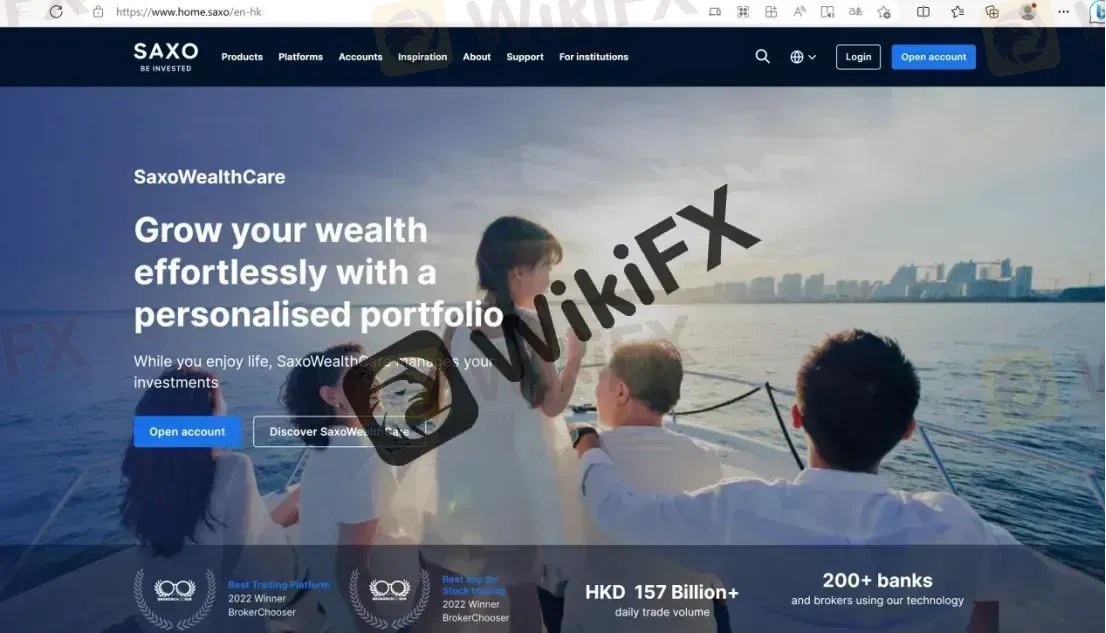
Saxo is a well-established and reputable broker with a range of trading platforms, instruments, and research tools.
However, the broker's high fees, minimum deposit requirement, and lack of negative balance protection may not be suitable for all traders. Additionally, some users have reported poor customer service experiences.
| Pros | Cons |
| • Wide range of financial instruments available | • High minimum deposit requirement |
| • Access to multiple markets and exchanges | • Fees and commissions may be higher than competitors |
| • User-friendly trading platforms | • Inactivity fee for dormant accounts |
| • Advanced trading tools and research | • Limited educational resources |
| • Regulated by top-tier financial authorities | • Limited customer support options |
Overall, it is important for traders to carefully consider their own needs and preferences before choosing Saxo or any other broker.
There are many alternative brokers to Saxo, each with their own unique features and benefits. Some popular alternatives include:
Interactive Brokers: A well-established broker with a wide range of trading instruments and low commissions.
TD Ameritrade: Offers a powerful trading platform and a variety of educational resources.
E*TRADE: A popular broker with a user-friendly platform and no account minimums.
IG: A global leader in online trading, offering a wide range of markets and advanced trading tools.
Plus500: A broker known for its user-friendly platform and tight spreads.
Ultimately, the best alternative broker for you will depend on your specific trading needs and preferences. It's important to research and compare different brokers to find the one that best fits your individual needs.
Saxo is a legitimate and reputable broker with a long track record of providing reliable trading services. It is regulated by top-tier financial authorities such as the Financial Conduct Authority (FCA) in the UK and the Danish Financial Supervisory Authority (DFSA). Additionally, Saxo is a member of several investor protection funds, such as the Financial Services Compensation Scheme (FSCS) in the UK, which protects clients' funds up to a certain amount in case of the broker's insolvency. Therefore, based on its regulation and investor protection measures, Saxo can be considered a legitimate broker.
Saxo is a regulated broker, with licenses from multiple reputable regulatory authorities and a long-standing history of providing financial services. The broker takes extensive measures to protect client funds, including segregating them from the company's assets and offering negative balance protection.
Additionally, Saxo offers various security features, such as two-factor authentication and encryption, to ensure secure trading.
More details can be found in the table below:
| Security Measures | Description |
| Regulation | FSA, FINMA, FCA, ASIC, DFSA |
| Segregated Accounts | Client funds are held in segregated bank accounts to protect them in case of insolvency. |
| Two-Factor Authentication | As an extra layer of security for client accounts |
| SSL Encryption | The Saxo website and platform are secured with SSL encryption to protect user data |
| Investor Compensation Scheme | A member of the Danish Investor Compensation Scheme, which provides additional protection to clients in case of insolvency |
It's important to note that while these measures provide some level of protection for clients, there is always some level of risk involved in trading financial instruments, and clients should always be aware of the risks before making any trades.
Based on the information available, Saxo appears to be a reliable and trustworthy broker. It is regulated by reputable authorities, has been in operation for several years. However, we also find that some users complain about their bad experience with Saxo. Take care!
Saxo offers a wide range of trading instruments across multiple asset classes, including
Forex: More than 180 currency pairs, including majors, minors, and exotics.
Stocks: Over 40,000 stocks from 36 global exchanges, including NYSE, NASDAQ, LSE, and more.
Futures: Over 200 futures and options across a variety of asset classes such as commodities, indices, and bonds.
Options: A wide range of options on stocks, indices, and futures.
Bonds: Trade a wide range of government and corporate bonds, including sovereign bonds from developed and emerging markets.
ETFs and CFDs: Access to over 3,000 ETFs and CFDs on indices, commodities, and stocks.

Saxo offers a range of account types designed to suit the different needs of its clients. The account types offered by Saxo are:
Classic Account: A traditional account with minimum funding of HKD10,000, which offers a range of trading tools and resources.
Platinum Account: A premium account for high-net-worth individuals, with a minimum funding requirement of HKD 1,500,000.
VIP Account: An exclusive account for ultra-high-net-worth individuals, with a minimum funding requirement of HKD 8,000,000.

Islamic Account: A Sharia-compliant account for clients who follow Islamic finance principles.
Corporate Account: An account for companies, partnerships, and other legal entities.
Joint Account: An account for two or more individuals who want to trade together.
Each account type has its own unique features and benefits, such as lower pricing, higher leverage, and dedicated account managers. Saxo also offers a free demo account for clients to practice trading before committing to a live account.
It takes only about five minutes and a short online form to open an account. Clients will need to submit the standard verification documents required by KYC and AML rules, but the procedure should be quick and easy, and they will have access to their account in minutes.

Saxo offers leverage up to 1:100 for forex trading. Professional clients are entitled to leverage of 1:40 for the primary index, 1:33 for the secondary index, 1:33 for gold, 1:10 for equities, and 1:25 for commodities. Retail clients are entitled to leverage of 1:20 for the primary index, 1:10 for the secondary index, 1:20 for gold, 1:5 for equities and 1:10 for commodities.
However, the maximum leverage may vary depending on the instrument being traded and the client's location. It is important to note that trading with high leverage carries a higher level of risk, and traders should always exercise caution and use risk management strategies.
Saxo offers variable spreads, which means that the spreads can change depending on market conditions. The typical minimum spreads for popular instruments are as follows:
EUR/USD: 0.4 pips
USD/JPY: 0.6 pips
GBP/USD: 0.9 pips
AUD/USD: 0.6 pips
USD/CHF: 1.2 pips
USD/CAD: 1.5 pips
Saxo also charges commissions on some products, including stocks, ETFs, and futures. The commission fees vary depending on the specific market and the size of the trade. Commissions start at $3 per share for equities, as low as $0.85 per lot for commodities, and $3 per share for ETFs. Futures commissions start as low as $0.85 per lot, bonds commissions start at 0.05%, listed options commissions start as low as $1.25 per lot, and mutual funds commissions are $0 for custody and platform fees.
Below is a comparison table about spreads and commissions charged by different brokers:
| Broker | EUR/USD Spread | Commission per lot |
| Saxo | 0.4 pips | $3 |
| Interactive Brokers | 0.1 pips | $2 |
| TD Ameritrade | 0.7 pips | free |
| E*TRADE | 1.0 pips | free |
| IG | 0.75 pips | free |
| Plus500 | 0.8 pips | free |
Please note that commission rates may vary depending on the specific account type and trading volume. Additionally, some brokers may offer different spreads and commissions for other currency pairs or financial instruments. It's important to do your own research and carefully consider the costs and fees of each broker before making a decision.
Saxo offers its own proprietary trading platform called SaxoTraderGO. It is a web-based platform that can be accessed from any device with an internet connection. In addition to SaxoTraderGO, Saxo also offers SaxoTraderPRO, a desktop-based trading platform that is designed for advanced traders who require additional functionality.
SaxoTraderGO is highly customizable, allowing traders to arrange the interface to suit their preferences. It provides access to a wide range of trading tools and features, including charting tools, technical analysis indicators, and news feeds. The platform also includes a comprehensive range of order types, including market, limit, stop, and trailing stop orders.

SaxoTraderPRO is a professional-grade trading platform that offers advanced trading tools and features. It is designed for active traders and includes a range of tools that allow traders to monitor multiple markets and instruments simultaneously. The platform also includes advanced charting tools and a range of order types, including conditional orders and algorithmic trading capabilities.

Saxo also offers SaxoInvestor, which is a user-friendly trading platform suitable for beginner investors who are interested in a wide range of asset classes. It provides a simple and intuitive interface with basic research tools and features, making it easy for investors to buy and sell stocks, ETFs, bonds, and mutual funds. However, advanced traders may find the platform's lack of advanced tools and customization options limiting.

Overall, Saxo's trading platforms are well-designed, user-friendly, and offer a range of advanced features suitable for both beginner and experienced traders. See the trading platform comparison table below:
| Broker | Trading Platform |
| Saxo | SaxoTraderGO, SaxoTraderPRO, SaxoInvestor |
| Interactive Brokers | Trader Workstation, WebTrader, IBKR Mobile |
| TD Ameritrade | Thinkorswim, Web Platform, TD Ameritrade Mobile App |
| E*TRADE | Power E*TRADE, E*TRADE Web, E*TRADE Mobile |
| IG | IG Trading Platform, IG Web Platform, IG Trading App |
| Plus500 | Plus500 WebTrader, Plus500 Mobile App |
Saxo Bank supports several deposit and withdrawal methods, including Visa, MasterCard, Visa Debit, Visa Electron, MasterCard Debit, Maestro (for UK residents), Visa Dankort (for Denmark residents), Carte Bleue (for France residents). The company does not charge any fees for deposits and withdrawals, but if an investor makes a withdrawal request via manual withdrawal, a processing fee of 40 EUR will be charged.
Saxo has different minimum deposit requirements depending on the type of account you open and your country of residence. For example, the minimum deposit for the Classic account is HKD10,000.
However, these amounts can vary depending on your location and the specific account type. It's important to check with Saxo directly or on their website for the most up-to-date information on minimum deposit requirements.
| Saxo | Most other | |
| Minimum Deposit | HKD10,000 | $100 |
To withdraw funds from your Saxo account, you need to follow these steps:
Step 1: Log in to your Saxo account using your credentials.
Step 2: Click on the “Account” tab located on the top right corner of the screen.
Step 3: Click on “Withdraw Funds” from the account menu options.
Step 4: Select the account you wish to withdraw funds from, enter the amount you want to withdraw, and select the currency you want to withdraw in.
Step 5: Choose the preferred withdrawal method from the available options and provide the necessary details such as bank account information or credit/debit card information.
Step 6: Review the details of your withdrawal request and click on “Submit.”
Note that Saxo may require additional verification or documentation before processing your withdrawal request. The processing time for withdrawals may vary depending on the chosen method and your bank's processing time.
Swap costs, sometimes called overnight fees, are assessed on overnight open positions at Saxo Bank. These are expressed as interest and, depending on the trader's position, might be either charged to or credited to his or her account.
Traders of the Muslim faith, for whom the payment of interest is forbidden, are out of luck with Saxo Bank because they don't have the option of opening an Islamic account. With the wide variety of deposit currencies offered by Saxo Bank, customers will have a decreased chance of incurring conversion fees.
Amounts credited to your account are converted from their original currency at the mid-point FX Spot rate plus/minus the margins and spreads indicated below. This includes both trading fees and profits/losses incurred as a result of your trading activities.
Fees for account inactivity are also a reality for inactive accounts. After the initial six months, the rate increased to $150, which is quite a bit.
See the fee comparison table below:
| Broker | Deposit Fee | Withdrawal Fee | Inactivity Fee |
| Saxo | Free | Free | $150 after six months of inactivity |
| Interactive Brokers | Free | $0-$10 | $20/month if account balance < $2,000 |
| TD Ameritrade | Free | Free | Free |
| E*TRADE | Free | $0-$25 | Free |
| IG | Free | Free | $18/month after 24 months of inactivity |
| Plus500 | Free | Free | $10/month after 3 months of inactivity |
Saxo provides customer support through several channels, including phone, email, and social media (Facebook, LinkedIn, Twitter and YouTube). The broker offers 24/5 customer service in multiple languages, including English, Chinese, French, German, Italian, Japanese, Portuguese, and Spanish.
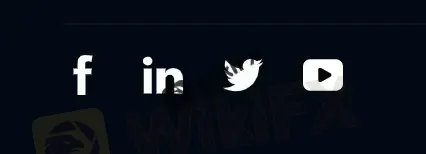
Saxo also provides a comprehensive help center on its website that includes an extensive knowledge base, FAQs, trading guides, and video tutorials. The broker's customer service is generally considered to be of high quality, with knowledgeable representatives who are responsive and helpful.

| Pros | Cons |
| • 24/5 customer service through multiple channels | • No 24/7 support service |
| • Dedicated support for VIP clients | • Phone support may have long wait times |
| • Extensive FAQ section on the website | • No dedicated account manager for non-VIP clients |
| • Personalized support for complex trading needs | • No local offices in some countries |
| • Multilingual support available for non-English users |
Note: These pros and cons are subjective and may vary depending on the individual's experience with Saxo's customer service.
Saxo Bank provides excellent market research in addition to a wealth of instructional resources like video courses, webinars, and events. Saxo Bank's SaxoStrats Experts group consists of eight analysts and strategists who are tasked with providing coverage of the various asset classes available to customers. It's apparent that this broker places a high value on its research team and recognizes the significance of this service, both for its clients and as a global investment bank. The classes are a wonderful way for newcomers to get their feet wet and become acquainted with the resources that are at their disposal. Videos are easy to follow and understand, helping novice traders quickly get up to speed and lay a solid groundwork from which to expand their knowledge. Saxo Bank specialists will be hosting webinars.
In conclusion, Saxo is a well-established broker. The broker offers a wide range of trading instruments, including forex, stocks, options, futures, and CFDs, and provides access to various markets worldwide. Saxo also offers an advanced trading platform and a user-friendly mobile app, making it easy for traders to access the markets on the go.
While Saxo has some of the highest fees in the industry, the broker's competitive spreads and tight execution make it a popular choice for traders. Additionally, Saxo's robust educational resources and customer support make it an ideal choice for traders of all skill levels who want to improve their knowledge and skills in trading.
Overall, Saxo is a multi-asset broker that offers a comprehensive suite of trading tools and services to help traders achieve their investment goals. However, potential clients should carefully consider the fees and minimum deposit requirements before opening an account. Also, dont forget check their user reviews on the Internet.
| Q 1: | Is Saxo regulated? |
| A 1: | Yes. It is regulated by ASIC, FCA, FSA, SFC, BDF, CONSOB, FINMA, MAS. |
| Q 2: | Does Saxo offer demo accounts? |
| A 2: | Yes. |
| Q 3: | Does Saxo offer the industry-standard MT4 & MT5? |
| A 3: | No. Instead, it offers SaxoInvestor, SaxoTraderGO, and SaxoTraderPRO. |
| Q 4: | What is the minimum deposit for Saxo? |
| A 4: | The minimum initial deposit to open an account isHKD10,000. |
| Q 5: | Is Saxo a good broker for beginners? |
| A 5: | Yes. It is a good choice for beginners because it is regulated well and offers various trading instruments with competitive trading conditions. Also, it offers demo accounts that allow traders to practice trading without risking any real money. |
To compare transaction costs across different brokers, our experts analyze the transaction-specific fees (such as spreads) and non-trading fees (such as inactivity fees and payment costs).
To get a comprehensive understanding of how cheap or expensive plus500 and saxo are, we first considered common fees for standard accounts. On plus500, the average spread for the EUR/USD currency pair is -- pips, while on saxo the spread is --.
To determine the safety of our top brokers, our experts will consider many factors. This includes which licenses the broker holds and the credibility of these licenses. We also consider the history of brokers, because long-term brokers are usually more reliable and trustworthy than new brokers.
plus500 is regulated by ASIC,FSA,CYSEC,FCA,FMA,MAS. saxo is regulated by ASIC,FCA,FSA,SFC,AMF,CONSOB,FINMA,MAS,AMF,DFSA,ASIC.
When our experts review brokers, they will open their own accounts and trade through the broker's trading platform. This enables them to comprehensively evaluate the quality, ease of use, and function of the platform.
plus500 provides trading platform including -- and trading variety including --. saxo provides trading platform including VIP account,Classic account,Platinum account and trading variety including --.